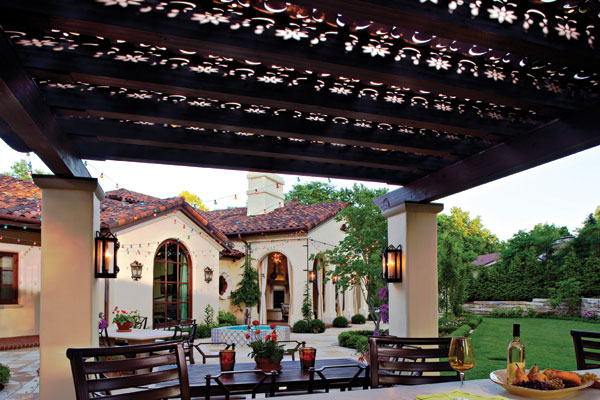Pattern Mapping for Lasting Design
Basic Elements of a Patterned Panel Installation
Identifying the type of pattern that will perform as necessary in the space is the first important decision to make in the specification of an architectural panel with a patterned opening. Next, designers must determine the amount of openness required in the pattern, the best base material to use for the panel, the desired texture or appearance of the physical panel material, and the overall scale of the installation.
Openness Factor
A panel with a patterned opening creates a pattern out of a combination of the base material and open space in that base material. The openness of the pattern refers to the portion of the pattern that is air and it is measured by referencing the percentage of the total panel surface that has been removed. A panel that has an openness factor of 25 percent has had 25 percent of the total surface area of the panel cut out.
The design objectives determine whether or not the ideal pattern for the project is more open or less open. Panels with more open space may be easier to see through and may not provide the best solutions for creating privacy or camouflage, but they may allow better airflow circulation when applied in an overhead shading capacity. A tighter pattern, with less open space, may be better at hiding or disguising items, but provide insufficient airflow when used to provide shade.
It is important to note that the openness factor simply measures the amount of the total panel that is open space. It does not describe the uniformity of those openings in any way. A panel that is 25 percent open could have a design of five large holes or 30 tiny holes. Although they have the same openness, the two panels will perform quite differently in terms of the distribution of shade and the quality of the air circulation they are able to provide.
Base Materials
Aluminum, copper, and steel are the three most common base materials used to create architectural panels with patterned openings. Each material has strengths and weaknesses that make it better suited for one type of application over another. Exploring these features will make it easier for a designer to select the base material that best meets the needs of a project.
Aluminum is a stable, lightweight, all-weather material that is rigid enough to support itself, allowing installations large and small to exist without requiring much structural support. Perhaps the greatest benefits of selecting aluminum for any installation are that it does not rust and that the material creates a strong adhesion bond with a powder coat offering impressive durability, even in applications that are regularly touched and handled by people.
Copper is a beautiful, valuable material that requires no maintenance. It is durable. It almost never rusts. It gets better and better looking as it ages due to its naturally occurring patina and it is an incredibly conductive material that can offer a great heat management solution for overhead shading panels.

Photo courtesy of Parasoleil
This raw copper architectural panel was designed to blend with the Spanish-style architecture and filter sunlight for an outdoor dining area.
The greatest limitation of copper from a structural capacity is that it is malleable, not rigid. For this reason, copper can be used to skin a façade, but it cannot be held up on its own weight, it must be well supported. Although copper itself is almost indestructible, copper causes corrosion in other materials. This is important to note, because copper needs to be supported and it is critical that a copper structure is supported with fasteners that will not react with it. Stainless steel fasteners are often used for this reason.
One interesting fact to remember about copper is that it rusts when exposed to bromine. Bromine is a chemical that is regularly used, instead of chlorine, to clean fountains and pools. If you place copper in water tainted with bromine, the copper will rust and disintegrate.
Steel is an attractive, rigid material that can be easily machined to create architectural panels with patterned openings. Unfortunately, steel rusts and stains everything around it. It is one of the greatest disincentives to specifying steel in outdoor applications. Weathering steel, often called Corten, was introduced as an alternative solution. This type of steel was designed to rust to a certain point and then stop rusting. Unfortunately, weathering steel was not designed for patterned cutout applications and when the patterned cutouts are removed from the weathering steel panel, it defeats the technology of the material.
The longevity of steel installations can be compromised by galvanic reactions occurring between the panel material, the fasteners, and the structural supports. Care must be used when specifying every element of these particular systems.
Other materials. Architectural panels with patterned openings can also be made from wood, printed metal, and other innovative new materials. Ensure that panel materials can withstand the elements of the environment in which they are placed. For example, wood is an excellent option for interior applications, but the amount of maintenance required when placing wood in an outdoor space may be prohibitive.









